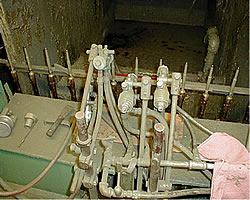Small Business Assistance - Permit Primer
Volatile Organic Compounds
A VOC or volatile organic compound emissions source is a unit that uses paints, inks, lacquers, adhesives, other coatings, clean up solvents or other solvents or materials that contain VOCs or create emissions of VOCs. Some examples of VOC sources include wood coating, metal part painting, plastic part coating, fabric coating, cabinet/countertop lamination, furniture coating, printing presses, screen printing units, and autobody repair shops.

You need to determine if you are exempt
Each process in the list below has a certain exemption level (listed in the drop-down definition box that appears when clicking on each one) that your process must be less than to be exempt. If your process is not below those levels, or you cannot substitute materials or modify the process to bring it below those levels then you are not exempt and will need to apply for a construction permit.
(Click on the drop-down topic below to review the exemption level, then refer to the facts sheets that follow)
Topics with Clickable, Drop-down Exemption Levels
- Use adhesives, coatings, paints, inks, other solvents or solvent containing materials
- Automobile Refinishing Operations
- Painting or Coating Operations
- Graphic Arts Operations
- Storage Tanks - Organic Compounds
- Storage Tanks - Volatile Organic Compounds (VOCs)
- Bulk Gasoline Plants
- Cold Cleaning Equipment
- Batch Cold Cleaning Equipment
- Open Top Vapor Degreasing Equipment
- Batch Open Top Vapor Degreasing Equipment
- Conveyorized Non-vapor Degreasing and Conveyorized Vapor Degreasing Equipment
- Perchloroethylene Dry Cleaning Area Sources
- Private Alcohol Fuel Production Systems
- Soil or Water Remediation
For help on calculating your VOC emissions, please review the following fact sheet (opens in new window)
Clean
Air Facts: VOC Sources Fact Sheet (Exit DNR) (PDF,
48 KB) ![]()
If you've determined you are not exempt, please continue by clicking the "Not Exempt" button below. This link will take you to a pollution prevention option web page.

